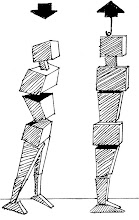
by Greg Brynelson (5/4/2010)
"Do you watch peoples posture all the time?" When people grasp what I do for a living this is often a question I get.
When I first began training for Rolfing (R), I'll admit I was a chronic posture observer. What I've found true over time is that often there are distinct, visible, unconscious cues between related people. In fact it is so dramatic - if you're looking for it you can find them yourself. You need no special training. Airport layovers are my favorite time to do this but a busy sidewalk in downtown S.F. or the mall are also good places to begin your study of the way people move and stand. Watch how people who are together (family/ friends/ colleagues) are similar or different in the way they move and express.
You may see a a husband and wife with the same carriage in shoulders and pelvis, the same tucked under buttocks, or the same chin-forward position. Or sometimes where one spouse moves well, the other moves poorly. Does this make one dominant - or make the other a passive controller? I wonder. I often wonder if mates shape each-others postural habits, or whether we just pick mates that move like we do. I imagine it's a bit of both - we learn to speak and adopt each others body language.
A very distinct impression of this unconscious posture - I've noticed - is in relations of child to parent. In the most dramatic cases where a parent has a limp or severe scoliosis, I've seen that the child takes on this habit (limp, or shoulder distortion). While the child is perfectly healthy, he mimics parent's abnormality.
In my travels (to India, Thailand, Australia) I have also noticed that different cultures and even genders within the cultures move differently. In India men move quite uprightly, have fairly narrow personal space bubbles, and are quite flexible in the hips but always seem to be holding onto back of the scapulae. American's men often move forward by pushing their shoulders and stiff hips into the space directly in front of them (not thinking about the entire 360 degrees that the body occupies) and have wider "personal space bubbles" around them. These are just examples and broad generalizations, but they are distinct and noticeable from culture to culture.
Because of this unconscious connection of movement from one individual to the next, I believe Rolfing (R) can be a positive experience for the entire human family; when one person begins to have more freedom in his or her body, it can allow other members to also feel that freedom, and unconsciously adopt that new movement pattern. In the case of parent to child this seems especially valuable. In fact Rolfing can be evolutionary in this way (Ida Rolf would be proud I'm saying this right now). Obtaining fluidity, balance, and awareness in our own body we end up shaping not only our selves, but our family, friends, and broader culture at the same time.
So I next time you look in the mirror think about your own parents, how do you look like them?
Take a few minutes to look at the people around you how are you similar in the way you move, how are you different? It's fun, and can be enlightening - or even slightly disturbing (whatever your mindset). Does my dog really walk like me too?




